The Future of Work in Financial Services
The last 15 months had seismic impacts on workforces and ways of working
Banks and insurers weren’t prepared for the pandemic – within days nearly every employee was working from home, all of the time. The initial response was crisis-mode transferral of existing activities, processes and tools to remote – with minimal adaptation.
Most organisations surprised themselves at how quickly this was achieved and asked why they couldn’t make change happen as fast outside of a crisis.
Rises in workforce productivity were reported (less evidenced), but this was partly driven by fear of job loss.
Homeworking conditions varied enormously, with many people dealing with cramped, noisy environments, unreliable internet connectivity, and competing childcare and work demands
Protracted home-working suited some but caused a widespread decline in mental and physical wellbeing for others*, particularly in larger households:
- 46% taking less exercise and 39% developing musculoskeletal problems
- 59% finding it harder to switch off from work and 37% reporting disturbed sleep
- 67% feeling less connected to or isolated from colleagues
- 41% of those living in households with 3+ people think working from home is worse for their health and wellbeing, vs 29% of those living on their own and 24% of those living with just their partner
Business leaders had to respond to a wave of 'here & now' imperatives
How to:
- Immediately ensure operational resilience and prioritise access for those who most needed service
- Adapt and mobilise rapidly to deliver Government-backed support scheme (BBLS, CBILS)
- Avoid customer resentment or loss as a consequence of exceptional service constraints – e.g. motor and health insurers compensating policyholders for reduced need to claim or ability to fulfil claims
- Best minimised disruption and restore service quality for all partners and customers
- Accelerate process and service digitisation to enable all this, e.g. increased chatbot use to manage contact demand
- Provision to manage significant financial risk, e.g. bad loans for banks and increased claims volumes for Life insurers
- Minimise furlough and redundancies and keep colleague morale and motivation high
- Ensure a safe, confident return to the workplace during those periods when permitted/required to
Expansive, strategic initiatives – like progress on sustainability, operating model and core technology change – were largely relegated down the agenda
Today’s focus is on transitioning to new ways of working which will best advantage organisations and colleagues after restrictions end
- The Government requirement to work from home whenever possible lifts on July 19th
- Though uncertainty continues with some senior scientific advisers urging continued working from home over the summer
- Return to the workplace is underway within Financial Services albeit under varying conditions, speeds and guidance
- Lots has been done on scenarios and plans for what the new ways of working will look like, and how they will be better…
But how ready are banks and insurers to execute their plans and take full advantage of the many opportunities the transition offers?
Visions of the Future of Work vary, and the best solution to many implementation complexities is not yet known
Simplistically, strategies divide between three broad options
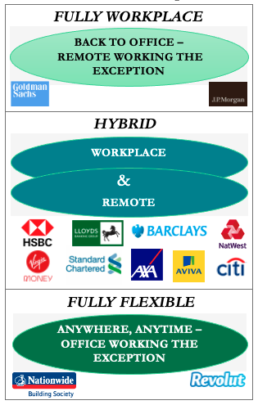
But one size won’t fit all
There are multiple work ‘personae’ with different required and desired ways of working:
- e.g. in the wealth management division of a bank, traders may be encouraged back to the office full time…
- where, Ops and Technology colleagues shift to a 1:3:1 week [1 day in the office, 3 at home, 1 flexible]
- while private banking account managers go to fully flexible
Many questions still need working through before the optimised hybrid model is found such as:
- What will the office be used for on return – which tasks and activities need to be conducted there and what changes in office design/functionality will best support those?
- What and how should policies flex to deal with exceptions, e.g. for people with lower comfort levels about returning to office-based or more cautious views of ongoing Covid risks?
- Where and how should front/middle/back-office processes and controls differ between the office and home?
- Where and why should this prompt a reshuffle of roles, interfaces, activities to maximise performance?
- Do certain roles no longer need to be attached to a site/location? E.g. could a UK job be done 100% from home in France?
- How to ensure similarity between home and office experience where it matters to avoid some colleagues feeling disconnected, and to bolster inclusivity?
- To what extent will savings from reduced office space outweigh costs of standardising/upgrading home working equipment, furniture, and technology?
The challenge is now to successfully translate the vision into the new operating and cultural reality… and deliver maximum benefit from it
The Future of Work challenge facing organisations now is how to actually ‘make it happen’
Moving to action is the hard part, and in our view, the effort needs two strongly coordinated legs:
- Piloting the practical changes needed to establish and embed target new ways of working – testing/learning and refining at pace to best effect across the entire business, attuned to the needs of different work personae
- Designing and delivering deeper change that goes beyond just re-configuring office space – to create maximum value by converting the breadth and depth of opportunities opened up by the FoW, so…
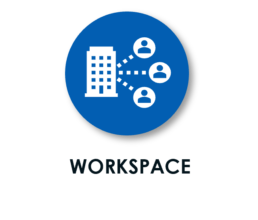
- Optimise and flex office access and space in synch with hybrid working needs
- Perfect the work-at-home equipped-ness and experience
- Convert cost-savings from real estate footprint and usage reduction
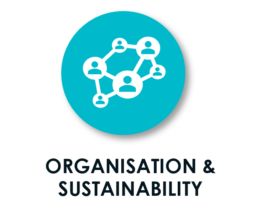
- Organise across functions and silos for hybrid working effectiveness
- Link WoW changes to delivery of CN0 & cost optimisation goals
- Raise employee engagement as a purpose-based organisation
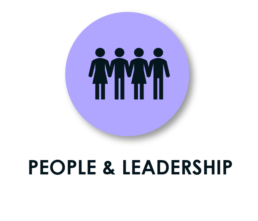
- Improve management, coaching, motivational techniques and controls to bridge in/out office split
- Skills & behaviours ‘upgrade’ for higher performance and positive culture change
- Enrich diversity and recruit the best talent from a wider geography
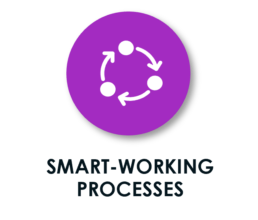
- Re-think routine activities for maximum efficiency
- Introduce smarter working processes to boost productivity
- Drive those pandemic customer behaviours (like increased digital payments) which boost productivity and enhance CX
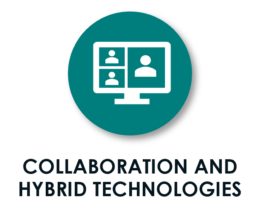
- Adopt best collaboration tools and AI/automation technology to improve work quality, pace, output
- Clear out under-utilised or no longer fit for purpose office collaboration / workflow tools
In delivering holistic change there is a golden opportunity to redefine the employee value proposition and enhance culture
Holistic change approach to the Future of Work
Designing to most compelling EVP for the future
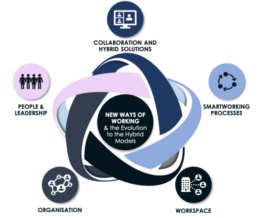
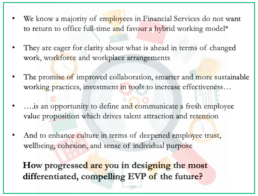
The human and commercial benefits of getting this right are BIG
Banking and insurance have amongst the highest remote working potential of any sector, with around three-quarters of time spent on activities that can be conducted remotely, without the loss of productivity*
Indicate scale benefits of transitioning to 50% remote working are £10M annual savings per 1,000 employees

There are important human capital and reputational /social responsibility benefits to derive from improved employee experience and accelerated reduction in the organisation’s carbon footprint***
* Source McKinsey / What’s Next for Remote Working
** Source Global Workplace Analytics, Amazon, SHRM, Deloitte – average annual savings include the cost of office rent, electricity, water, insurance supplies. Savings based on full-time employees with compatible jobs telecommuting 20 hrs/wk. Assumes 2,000 hour work year and £70/hr labour rate
*** Source Carbon Trust / Homeworking
So… the questions we think you need to be able to answer are…
Strategy
Does your FoW vision and ambition reach far enough?
Is your FoW strategy holistic and clear on what benefits the new ways of working should deliver, in terms of
- human capital
- culture change
- productivity
- operational efficiency
- customer experience
- cost optimisation
- carbon reduction
How robust is the supporting business case and rationale?
Change Design
Do change designs have the necessary sensitivity and granularity at policy, process, controls and performance management levels? Do they have
- defined rules and variability on when in-person presence is required by specific roles, activity mixes and situations
- mitigations of risk of accentuating inequalities and creating new psychological or emotional stresses amongst employees
Test – Learn – Optimise
What will it take to pilot, refine and embed the transition effort successfully and at pace?
Enablement
What needs to be achieved to ensure the organisation and people are ready to adopt the new ways of working?
Have you identified/selected the optimal system, technology and data solutions to enable the hybrid working model?
Benefit Capture
To what degree can you be confident you have the right implementation plans, measures and capabilities to realise the target model and benefits?
We would welcome a discussion to understand where you are in moving from visioning to delivering FoW and which questions matter most to you, and to explore where Curzon’s capabilities may be relevant to your needs
CONTACT US TO FIND OUT HOW WE CAN HELP
Future of Work insights
Sign up to our insights
Future of work: healthcare med reps transformation
In his latest blog post relating to Future of Work, Curzon’s Managing Consultant Rodrigo Quezada Dighero focuses on the transformation of healthcare medical sales reps.
Exploring how the pandemic has disrupted the face-to-face salesforce, and the unique opportunity this presents to adapt the operating model for future success.
The effectiveness of a disrupted salesforce
One year into the pandemic and face-to-face sales look very different from 12 months ago. Medical Reps are facing exceptional challenges in reaching their sales targets, as restrictions on in-person meetings with HCPs continue.
The gravity of the situation is reflected in the 16 new drugs launched during COVID-19 lockdowns, that are at risk of sales failures, according to one pharma consulting group.
However, the lifting of lockdowns is unlikely to return the industry back to ‘normal’. In fact, the evidence shows a stark reality for in-person sales.
-
About 60% of surgeons believe that restrictions on in-person sales are likely to remain even after a Covid-19 vaccine is available and lockdown restrictions abate.
Percentage who believe restrictions on face-to-face visits are likely to continue after Covid-19

Moreover, the changing landscape is not just a result of the pandemic; it’s expedited the necessary changes, but fundamentally, companies have been very slow to adapt their operating models to address the needs and wants of their customers and workforce.
-
Of the 75% of physicians who preferred in-person visits from Medtech representatives prior to Covid-19, 47% would now opt for a virtual exchange or less-frequent visits.
-
Many physicians once sceptical of any virtual interaction with sales reps now report these exchanges are high quality and offer a much better experience.
Healthcare providers are demanding more from pharma, as they seek greater value from their interactions with Med Reps.
-
69% of doctors now want digital patient education
-
67% want more education on remote patient care
-
65% need specific information on conditions relative to COVID-19
-
65% require information to help patients access labs, tests and imaging
It’s clear as medical professionals endure the uncertainty caused by COVID-19, changes are here to stay, and adaptation is crucial to success.
Identifying the opportunity - a new way of working
Digitalisation has accelerated the Next Normal requiring pharma operating models to adapt, or in some cases, completely transform to help them to thrive or even survive.
In this context, the need to provide refined, enriched collateral to healthcare providers and doctors demands an evolution from face-to-face meetings and conferences into a hybrid exchange of virtual and in-person meetings, steered by medical reps.
Percentages of doctors who prefer in-person sales visits
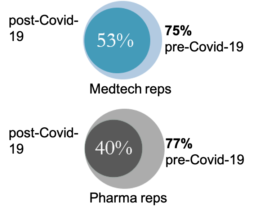
However, in order for this to be fully realised, pharma companies need to adjust and develop their salesforce capabilities. In another study, research shows that only 26% of pharma reps get coaching personalised to their needs. A focus on sales coaching, through integrated, personalised and value-driven interactions will support med reps to identify target prospects and align the products to the needs of the HPC, through their preferred communication channel.
Moreover, managers and leaders need to align sales & marketing, to ensure a collaborative approach to fully understand the customers and the local market they operate in. Communication and insight must flow both ways to drive communication strategies, content creation and support product development.
Our approach
Our approach to New Ways of Working accelerates the adaptation to the digital business model, focusing on the delivery of required capabilities and the evolution towards a hybrid model.
For this specific transformation, we focus on four of the five key areas
-
Organisation
-
Collaboration and Hybrid Solutions
-
Smartworking Processes
-
People & Leadership

Organisation
- Develop strategies that assist medical reps throughout the sales process, tailored to every customer touchpoint.
- Establish hybrid teams that can develop relevant, channel-specific, timely content to empower the med reps.
- Foster internal engagement and alignment by creating a purpose-based organisation with a relentless focus on value-add customer service.
- Entrench company culture to sustain new ways of working and improve business agility – always listening… constantly evolving.
Collaboration & Hybrid Solutions
The virtual nature of teams and work communities spearheads the need to adopt solutions that enhance and facilitate effective remote interactions.
- Optimise team relationships, roles & interactions to enhance hybrid ways of working.
- Design and implement collaboration solutions applied to the business and team leadership.
- Adopt collaborative tools, enabling sales & marketing teams to share opportunities that improve the quality of exchanges, content creation and value-based interactions regardless of location.
Smartworking Processes
Achieving process transformation through re-engineering & automation to create a generation of agile, flexible, efficient and collaborative working dynamics.
- Redesign smartworking processes, harnessing automation and flexibility to accelerate change and bring the hybrid model alive.
- Employ digital tools to evolve sales, HCP engagement and bring the customer experience to the forefront of every interaction.
- Remove silos to cultivate employee engagement and shared knowledge/opportunities.
People & Leadership
Evolution of culture and people is the foundation of Digital Transformation enabling leaders of pharma companies to steer a change in behaviour and actions.
- Adapt the hybrid model and embed culture based on learning and sharing.
- Develop salesforce capabilities with a focus on digital skills, converging efforts to support sales requirements through content creation and content sharing.
- Embed a coaching culture that fosters learning and sharing.
- Deploy cultural change that embraces and cements the New Normal.
The time to act is now
We work with pharma businesses to deliver New Ways of Working that accelerate the adaptation to the digital business model. Ultimately our work helps businesses to grow, improve customer retention and discover new opportunities.
Ask us how we can help your organisation to transition into the New Ways of Working putting your salesforce ahead of the curve.
CONTACT US TO FIND OUT HOW WE CAN HELP
Future of Work insights
Future of work: navigating uncertainty through agility
In his latest blog post relating to Future of Work, Curzon Managing Consultant Rodrigo Quezada Dighero in collaboration with Silviu Paraoan, explores how an agile approach focused on people and customers can lead to competitive advantage. This is particularly important now, as businesses are navigating uncertainty caused by COVID-19.
How employee and customer centricity are the key to an agile organisation
In Q4 2019, companies were finalising growth targets, key priorities, strategy, hiring needs and budget. Yet many businesses have spent 2020 in survival mode, putting the 3 year strategy on hold to necessitate a short term focus on business continuity.
Now, as many businesses enter Q4 2020, leaders revisit the original 3-year strategy plans as they look towards recovery. This inflection point is a great opportunity to adapt to the new world order and practice strategic foresight, as J. Peter Scoblic would say. In fact, this is not just an opportunity; the reality demands that you revisit strategy, adapt, and align your capital expenditure to this new paradigm. Becoming agile is the name of the game, to remain in the game, and to stay ahead of the rest of the players amid the disruption. In this new reality Winner takes All, and to be one, you need, you really need to reassess, adjust and plan your strategy.
Business continuity is one way of responding to disruption. But many people – including me – hold the belief that business continuity won’t be enough. Furthermore, it could put you behind competitors and faced with the risk of becoming obsolete. The time is now to think holistically about how to create opportunities in this new reality and adjust your business and operating models to serve the current and future needs of customers and employees. Two key areas are:
The agile organisation – how are you going to create an organisation that is adaptable, flexible and agile? When I talk about agile, I don’t mean a system. I’m referring to an agile organisation mindset characterised by collaboration and creativity. This means setting up the supply chain, procurement, and people strategies. It means employee engagement and training to encourage creativity and innovation from sales and marketing to operations and supply chain. It means developing a strategy to strive and thrive.
Customer centricity – how are you going to deliver products and services? Businesses will need to evolve to serve in this new environment in which customers have different expectations and needs.
The agile organisation
As you conduct your strategic thinking on this first area, there are a few key concepts to bear in mind:
- Overcommunication is key – align employees behind strategic priorities through clear and empathetic communication
- Use technology to augment, not replace, people
- Focus on people instead of processes
- Be flexible
- Collaborate – look for cross-functional collaboration. Maybe it’s time to start building that Business Ecosystem we have been theorising about for so long and make this opportunity a long term approach
- Keep it simple – this is not a time for dense multi-page documents. The agile approach of single-page, action-oriented documents with crystal clear communications is the order of the day.
- Embrace the new cultural and behavioural shifts
Customer experience
How will companies and their operations evolve to recreate the customer experience? Changes will of course create both challenges and opportunities in technology and creative approaches to developing new ways of delivering new systems and products. Done well, this can create significant competitive advantage.
The reimagining of customer experience is a challenge shared across industries. For example, how is banking going to change to better serve its customers? What will supermarkets do to enhance the shopping experience in this new environment?
According to an article in the Harvard Business Review, Bank of America converted more than 3,000 employee roles to meet the demand of additional customer calls during the crisis. In China, companies began an employee “sharing” program across the grocery store industry to meet the need for the delivery of grocery store items.
Agility is key to navigating uncertainty and understanding, meeting and exceeding new, evolving and emerging customer expectations.
Recalibrating strategy
The process is not about recreating or redesigning your strategy. It’s about realigning and calibrating what you had to serve in this new environment. What is the gap that has been created between your previous strategy and this new normal, and how are you going to serve your customers?
From my experience, you can do it from four dimensions:
- Digital – What technology is yet to be discovered or that is in place today that can help you to bridge that gap?
- Systems and processes – consider what current systems and processes will need to be replaced, modified, or switched to allow a better level of flexibility? What can be changed to allow employees to perform their job functions with excellence?
- Capabilities – how are you going to develop the required capabilities into your people for them to identify those gaps and cover them through the digital dimension or processes and systems?
- Physical location – covers the physical location. It is common to hear industry leaders talk about a spike in satellite offices. Is that the right option for you? Do you need to rethink your footprint or can you take advantage of your current location and layout to benefit new operations?
Finally, the most critical part of transformation is collaboration. By listening to employees and customers, you can strategise, realign the operations, and quickly redeploy the strategy in an agile way within the new normal environment.
A few companies are taking actions into this direction, and results are actually promising. One clear example is Nike which beat profit estimates in the quarter ending August 31st 2020. With physical sales decreasing due to COVID-19, Nike shifted focus to direct sales to consumer and digital channels. Their adjustments in strategy led to 82% increase in digital sales.
Key questions for leaders
- How will you quickly adjust your business strategy and associated goals to reflect the turbulence in the marketplace and maintain a competitive advantage?
- Is your workforce engaged, productive, and healthy during the continued disruption?
- Is your business learning and adapting to be prepared for the next disruptor?
- How has your service or offer changed because of COVID? (Front office and back office)
- How has overall the customer experience changed in your business/sector due to COVID?
- How have you been adapting your operations over the last 6 months and how are they going to keep evolving based on needs?
These questions should help you to identify areas of focus and strategic priorities that your people can work towards.
The time to act is now
We work with businesses to deliver an agile framework to determine the key factors to quickly adapt, optimise people strategy and enhance your digital capabilities. Ultimately our work helps businesses to grow, improve customer retention and discover new opportunities.
CONTACT US TO FIND OUT HOW WE CAN HELP
Future of Work insights
Understanding the new workforce drivers
Curzon Managing Consultant Rodrigo Quezada Dighero shares his thoughts on the new workforce drivers.
Covid-19 is disrupting the ways in companies can engage and reward their workforce, traditionally a key factor to retain talent. Organisations should be using this opportunity to re-evaluate reward programmes and incentive models, paying close attention to employees’ changing values.
A time of disruption
Before the coronavirus pandemic, companies employed a wide range of benefits to engage and reward their employees. These spanned from pay increases and bonuses (monetary incentives), to office experiences such as in-house chefs, ping pong tables and lounges. Creating a great experience in the office was key to having a competitive edge with your rewards system.
Up until the pandemic, it could be said that key employee engagement drivers included the above listed rewards. However, the lockdown, enabling many to work from home, created a shift. A recent study showed that economic disruption and uncertainty brought high levels of anxiety for employees over their personal job security for over 64% of the global workforce. The result has been people committing long hours and working harder. For example, Rightmove Chief executive Peter Brooks-Johnson, said in March: “I’ve been encouraged by how seamlessly people have adapted to working from home and how productivity has increased over the past few months.” The property website has over 530 staff who moved to home-based working since March.
The new driver for employees shifted from an enjoyable working environment to keeping their jobs and their financial stability. For many, this was also balancing household responsibilities, taking care of family and working in cramped conditions. Suddenly work/life balance became a work/life blur. People adapted in order to maintain business continuity, but at a cost. Furthermore, a recent study showed that 62% of people trusted their employer to respond responsibly to COVID-19.
Now, as companies look to the horizon, people are also considering what the new normal will be for them in their working lives. Companies need to be aware of this when planning workforce engagement principles for the future. The focus is no longer on solving employees problems within the office, but rather it should include their household and life challenges.
It is important for companies to understand what the new drivers for employee engagement are, and adapt to better serve those new drivers. This will provide the right incentive for employees to remain engaged, creating a new environment to not just survive but thrive at work.
A great start
In May, Twitter communicated that staff would be able to work remotely forever if they desired. The communication from Jack Dorsey is an example of paying attention to what people were struggling with, a new reality. This was strengthened by an additional benefit – the provision of equipment to transform their home into an office.
The pandemic has increased the trend of employers playing an expanded role in their employees’ financial, physical and mental well-being. Support has included enhanced sick leave, financial assistance, adjusted hours of operation and child care provisions, special allowances for work-related need such as Ergonomic chairs, monitors and Wi-Fi. In the case of a workforce that cannot operate remotely, setting extra precautionary measures such as safe commuting alternatives and workplace adaptation have been the norm.
The current economic crisis has also pushed the bounds of how employers view the employee experience. Personal factors take on a new importance for organisations and employees alike. Employing a range of measures can be an effective way to promote physical health and improve the emotional well-being of employees.
But there’s still no clarity on the long term impact of COVID on the workforce.
The time to act is now
It is often difficult to create change or transformation within organisations. The present time offers an opportunity for organisations to change their people strategy and create more efficient and productive ways of working. Key considerations are:
Design from your people, not for them
Ask your workforce, and put yourself in their shoes, this is an extremely important time to listen to what your workforce cares about the most, and design your plans and drivers around it.
Communicate often with authenticity, compassion and confidence
One of the actions we saw in our clients that provided calm to high levels of anxiety on their workforce was continuous, honest and open communication.
Proactively seek feedback from employees and give them a voice, and let them lead. Ensure leaders share their own COVID-19 experiences.
Build trust with people through purpose
Uniting employees under a common purpose can be a strong motivating factor which is important during a challenging journey of change. Purpose-driven organisations are more flexible and better at navigating uncertainty.
Support households, not just employees
Workplaces may be starting to reopen, but uncertainty prevails for employees in other areas of life.
This highlights the importance of mental health support, employee assistance programmes and well-being initiatives to help people adapt during a difficult time.
Revisit policies, focusing on the most vulnerable groups, such as temporary workers, people with disabilities, single parents or those who lack adequate health benefits.
Remember, design the plan by asking your people; prepare your people to be in action, engage them into the new order, and finally, prepare to lead. Times like these require active leadership and consistent communication.
Working from home or living at work?
COVID-19 has brought unprecedented challenges. Many companies have risen to the occasion, acting swiftly to safeguard employees and migrate to a new way of working that most business-continuity plans hadn’t envisioned. Across industries, leaders will use the lessons from this time to re-imagine how work is done, and what role offices should play, in creative and bold ways.
This pandemic has also highlighted that work and personal life are closer than once thought. Merging work and home over the past months proved that there are new motivators that people are looking for from organisations. Understanding this new reality is crucial for companies to recruit and maintain talent, so adapting quickly is key.
The time to act is now. This is a unique opportunity to engage your people, address change and understand what the new reality demands from your business.
For that, you will need to listen and adapt. We have experience in change and we have put some approaches to help you in that process. We can help to design and implement a strategy that helps your organisation to manage change and drive workforce effectiveness, efficiency and engagement.
CONTACT US TO FIND OUT HOW WE CAN HELP
Future of Work insights
The future of work
The Future of Work
COVID-19 has accelerated and amplified Future of Work trends impacting HR organisations and their enterprise partners.
As businesses work towards recovery and return to work, we explore what an effective people strategy and change management looks like.
Many organisations are now in a reactive mode and focused solely on business continuity. We can help organisations adapt their strategy and return to key fundamentals or create a new path forward.
Get strategy back on track – or a create new path. We will guide your strategy adaptation and a clear plan for execution.
Organisations are set to transform their workforce and workplace. It is increasingly important to be more agile while re-imagining the employee experience and emerging technologies to be successful in times of rapid change.
Organisations must align around a vision of future-ready talent and new modes of working. This means embracing the world of human, machine, physical, and digital to make near-term progress that delivers long-term opportunity.
Now is the time to develop and execute a human-centric plan for peak workforce efficiency and effectiveness.
As businesses begin their return to the workplace, there are a lot of questions to consider. Keeping people at the forefront of every decision is critical to a successful return. Our contact tracing solution, together with Nextconinent citizen Umlaut, helps organisations to keep their employees safe.
In collaboration with Point B
We have collaborated with our global consulting alliance (Nextcontinent) partners, Point B, to provide cross-border expertise on the future of work.
Some of their workforce experience insights:
- Guiding principles of remote working
- Inclusion in a virtual workspace
- Business continuity while working remotely
- The future of work is now webinar
Read our latest thinking below.
Future of Work insights
CONTACT US TO FIND OUT HOW WE CAN HELP
Remote working during COVID-19 - "Kudos is better than caffeine"
In his first blog post, senior consultant Phil Hanson explores seven lessons he learned in the army that can be applied to remote working during COVID-19.

Image courtesy of Johnny Fenn Photography
People naturally avoid difficult conversations
Ten years in the Army taught me more than I could possibly convey in a single thought leadership piece. However, some of my experience, including front-line combat in Afghanistan, left me some unique insights into team dynamics and leadership in extreme circumstances, many of them pertinent to the COVID-19 pandemic. The seven lessons I learned during my Army career I feel most useful for thriving under difficult conditions are:
Everyone responds differently to stress, and that’s OK
Like infectious diseases, stress responses have a lag time which can vary enormously by individual. This means treating people with patience, followed-up with a bit more patience.
Personality is a poor predictor of stress-response; I have witnessed shy, retiring individuals quietly carrying teams through astonishing adversity. The only consistent truth is that the appropriate response involves patience, compassion and understanding.
Consider the most candid conversation you’ve ever had; someone truly opening up to you about something personal. Now reflect on how it began. It probably meandered through small-talk before finally settling on the real issue once they felt comfortable enough to raise it.
Remote-working makes it too easy to close conversations early. Give people your time, make them feel valued and listened to: Make difficult conversations that bit easier.
Trust is not optional in high-performing teams
It’s often said that what sets the British Army apart is the quality of its Non-Commissioned Officers: Highly-trained, empowered junior mangers who are told what to achieve, not how to achieve it, in a concept known as Mission Command. This reciprocal-trust environment brings out best of the team’s collective strengths.
Virtually everyone responds best to a default position of trust; and will strive to justify this faith placed in them. The rare exceptions to this rule are rapidly exposed, rendering the concept of “respect is earned” redundant in the modern consulting profession.
Professionalism is a mindset
In 2015 my Battalion received new Colours from the Queen: The parade was the culmination of months of painstaking rehearsals and uniform preparation. The result of this was that on the day, leathers polished and medals shining, I felt utterly prepared to perform in front of 20,000 people. Equally, I would never deploy on operations without every bit of my kit being just-so. Both scenarios boil down to one principle: Being every-inch the professional soldier.
Wearing pyjamas whilst WFH every other Friday may be an understandable novelty, but long-term, looking and feeling in work-mode is critical to working in work-mode. It also helps delineate work-life balance.
You have to look after yourself in order to take care of others
Being an infantry officer often involves rapid decision-making whilst exhausted, soaking wet, and freezing cold. Typically, this means making personal sacrifices for the sake of your soldiers, but a good leader knows they need to take sufficient care of themselves to make the right tactical decisions.
It’s too easy to neglect ourselves, convinced we’re doing right by colleagues, friends and family. Granted it’s a tricky balance to strike, but the longer difficult scenarios last, the more important it is to take care of ourselves too. It’s what’s best for the whole team.
Followership is just as important as leadership
Despite all knowing that too many cooks spoil the broth, when we analyse team dynamics, we too often focus exclusively on leadership qualities at the expense of others.
Whether you call it followership, or just being a team player, the art of knowing your role, doing it to the best of your ability and supporting leaders is an often-overlooked critical success factor for high-performing teams.
Kudos is better than caffeine
Whilst it may not exactly be ground-breaking news, it’s nonetheless true that most people could be better at giving credit to others. When the going gets tough, it’s easier than ever to forget to say well-done, despite it being more important than ever.
Coffee may flow through the veins of many consultants, but recognition for job well-done provides a boost that is far more enduring than a caffeine fix.
CONTACT US TO FIND OUT HOW WE CAN HELP
Forming the new organisation around purpose
Managing Consultant Rodrigo Quezada Dighero attends Working Futures on 13 November 2019. At this event, they’ll be discussing the challenges HR Directors need to overcome to deliver greater productivity, digital transformation and formalise new strategies around organisation purpose.
HR's changing role
HR’s role now is to deliver the performance, frameworks and environments for both people and systems to allow true business transformation. This requires HR to reorganise itself and to grasp the purpose of the organisation and formalise new strategies around the purpose of the company.
We’ll be attending Working Futures on the 13th November 2019. There we will debate these elements and provide the shift in thinking that HR Directors now need to form the productive organisation.
Challenges organisations face
- Disruptive technologies
- Low entry barriers, new segments served
- Short product lifecycles
- Stress, wider product portfolio, product profitability
- More demanding customer experience
- Customer service, customer journey and customer lifecycle
- Multi-generation workforce – there are now 5 generations in the workforce
The challenges leaders face is how to envision, set and lead a flexible organisation that can quickly adapt and thrive in an ever changing and demanding environment
Creating a flexible and meaningful organisation requires a different approach
Forming strategy around purpose
Purpose:
- Allows peers and management to set a connection towards something bigger than just business profits
- Enables a multi-generation workforce to connect around a greater outcome
- Encourages disruptive design and thinking
- Allows the company to adapt, move and thrive by creating the products and services that best serve clients
- Facilitates flexibility to respond rapidly
- Provides speed to execution and calibration
- Allows people and teams to risk and innovate
- Eliminates silos, fostering interdependence, trust and team work
Many high-growth companies use purpose to generate sustained profitable growth, stay relevant in a rapidly changing world, and deepen ties with their stakeholders.
Targets and incentive plans became cross-functional, designed to build capabilities both within and across businesses. And at every step, purpose helps everybody in the company understand the “why”.
Questions leaders can ask about their organisation
Leaders need to constantly assess and calibrate how purpose can guide strategy, and they need to be willing to adjust or redefine this relationship as conditions change. Questions Leaders and People/HR Directors should be asking are:
- Does your company have a purpose?
- Do your company have a clear vision?
- What drives your company’s vision?
- Is your vision based on a clear purpose?
- Are your plans and projects tightly connected to your purpose and business outcomes?
- Are your people aligned around your vision?
How we can help HR Directors to align the organisation around purpose
- “From There To Here” Design
- Transformational maps
- Pathways definition
- Disruptive design
- Interdependence and shared outcomes
- Identifying Blockers and gaps
- Identifying Behaviours
- Putting in place new structures
In addition, we can help HR Directors with
- Strategic Workforce planning
- Digital Transformation
- HR Transformation
- Change management
- Recruitment Excellence – readiness assessment and implementation
- Culture
- People
- HR Target Operating Model
- HR Processes
- HR Supplier Management
- HR Rewards
- Talent Acquisition and Management
- Performance Management
- HR ITS and Applications (WorkDay, SAP HCM, Oracle HCM)
- Programme and Implementation Support
Get in touch to find out how we can help your organisation with strategy, digital and HR transformation.
CONTACT US TO FIND OUT HOW WE CAN HELP
How to leverage your workforce
In his latest blog post, Rodrigo Quezada explores what business leaders can do to manage a workforce comprised of five generations.
Make your workforce your secret weapon
In the workplace, times they are still a’ changing… For businesses to remain prosperous they need to face a number of challenges, including how to leverage an inter-generational work force with different needs and motivations. In fact, today’s workplace can contain up to five generations: Traditionalists, Baby Boomers, Generation X, Millennials and Generation Z.
Business models are navigating disruptive technology and changing customer needs. In addition, companies across all industries need to be able to leverage their workforce to maintain their competitive edge. So, with such a diverse workforce that covers a wide range of generations, how can leaders keep their people engaged, productive and motivated? When designing organisation transformation programmes, these are the goals that I focus on. Whether the workforce is comprised of Traditionalists, Millennials, Gen X, Gen Z or all of the above, designing specific organisational structures to keep everybody working at their optimal levels in the workforce is key.
The generations redefining the workplace
Definitions of Millennials and Gen Zs, and the distinctions between them, vary according to the source. No matter the definition, these generations have transformed how people engage with work and communicate. This is influencing the way businesses must operate, now and in the future.
Characteristics of Millennials and Gen Zs
There are always be exceptions to the rule, but there are broadly a number of characteristics that define these generations:
-
- Experience over material– One study found that 78% of millennials would choose to spend money on a desirable experience or event over buying something desirable, and 55% of millennials say they’re spending more on events and live experiences than ever before. This affects the appeal of traditional perks offered by companies to their employees.
- Responsibility – Purpose is king and wider social value is becoming an increasingly important factor
- Digital – As ‘digital natives’, communication and consumer purchases are driven by digital devices and platforms
- Flexibility – Working 9-5 is no longer the way to make a living. Flexibility is increasingly important. As featured in a The New York Times article this week, “the rest of their lives happens on their phones, not tied to a certain place or time — why should work be any different?”
Enabling "Generation Go" to Stay
Millennials have been nicknamed “Generation Go”. To utilize their energy and commitment in the workforce, businesses need to provide flexibility and keep pace with them, or risk losing out on the very competitive edge that comes along with the innovation they bring. Traditionalists, Baby Boomers and Gen X leaders need to find a way to share their business knowledge with millennials. Currently, millennials are managing 65% of the work of others globally. If you haven’t focused on the retention of this generation, you could lose leverage. Studies have shown that millennials are more likely to change jobs due to the economy over previous generations.
The top reasons Millennials and Gen Z choose to leave a job is:
- Lack of shared purpose and connection to a bigger goal
- Minimum wage growth
- Lack of advancement opportunity
- Excessive hours
- A work environment that doesn’t foster teamwork
What business leaders can do
As a business leader, it’s important to understand the mentality of your workforce. This is increasingly complex due to the multiple generations. Some basic cultural elements will never change such as having decent morals and respect for your fellow employees, but truly understanding how different generations tick could be the driving force for a successful business. By the year 2025, it is predicted that 75% of the workforce will be comprised of Millennials and Gen Zs. Therefore business leaders must understand how to attract millennials, retain them, and maximize their job performance.
Importantly, business leaders must also know how to effectively create succession plans while maintaining a strong focus on execution and innovation, incorporating new generations like Millennials. Sharing skills between generations is key – adopting new ways of communicating while also passing down the critical business knowledge that has been accumulated throughout the organisation. For a successful workforce, leadership must excel in understanding their employees and how to leverage different types of knowledge to excel and lead in the market.
Communication is a two-way street
In my experience I have found that the most effective way for senior leadership teams to engage in this two-way channel is to create special spaces like buffer zones which include forums, channels, and programmes that consistently maintain an open communication kept alive and relevant on both ends. This, combined with the more classic approaches like Leadership Development Programmes, and High Potential programmes give enough “credentials” for a programme to be taken seriously and succeed over time.
Key questions business leaders can ask about their culture
If companies want to become generational friendly and attract an elite and talented workforce to keep the company progressive and lucrative, it may be time to make some changes.
- Does your company have a clear and shared purpose? Statistics now show employees perform better when they feel a connection to peers and management towards something bigger than just profits and business results
- Is your company culture rigid or flexible? Foster a community-type atmosphere. Get rid of the top-down management structure and replace it with a more lateral management approach with tons of open communication.
- Does your company still require formal business wear every day? Change to a more casual dress code, dress down.
- Are your incentive and compensation schemes effective? Start offering perks that go beyond cash bonuses that studies show are so easily forgotten. Instead, offer company vacations as incentives.
Enabling each employee to share their skills with the wider team, regardless of generation, is key. With the tremendous amount of knowledge and experience older generations have, offering apprentice and mentorship programmes are a great way to make the top and bottom of organisations closer and close the gap that may exist between different approaches. It is one of the best ways for business leaders to engage new generations and identify new business opportunities for the long term growth and path of an organisation.
Learn to leverage your workforce, and make it your secret weapon.
About the author
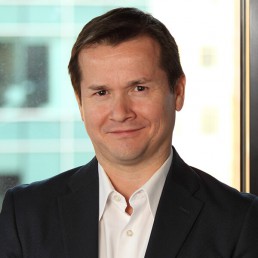
Rodrigo Quezada
Rodrigo is a strategy and operations Managing Consultant designing and leading business transformation projects




















